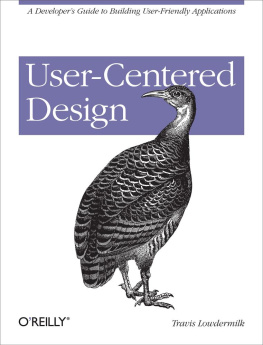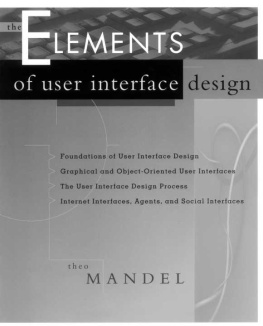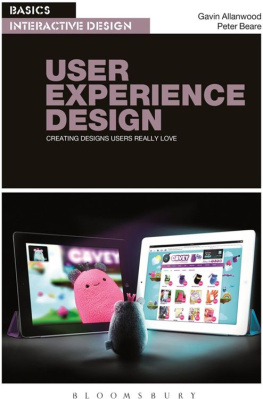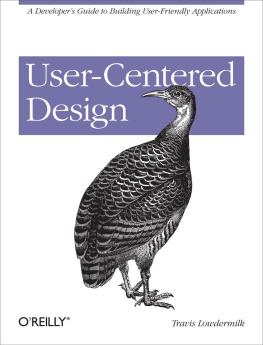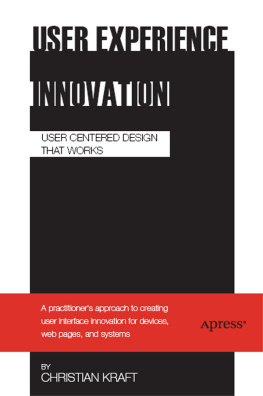If you purchased this ebook directly from oreilly.com, you have the following benefits:
If you purchased this ebook from another retailer, you can upgrade your ebook to take advantage of all these benefits for just $4.99. to access your ebook upgrade.
Is This Book Right for Me?
I sure hope so. Lets see if I can help set expectations.
In the many years Ive been building applications, Ive spent a great deal of time trying to understand users. Im obsessed with figuring out how they tick: What motivates them? What frustrates them? What makes them choose one application over another? What can I do to get them to choose my applications?
Based on the many discussions Ive had with developers from all over the world, its safe to assume that Im not alone. So, Ive decided to write this book to help developers better understand their users. This book is not meant for the user experience (UX) professional or professional designer. Instead, my goal is to help uninitiated developers understand the fundamental practices of user-centered design, usability, and user experience.
This discussion should be your launch pad into the world of usability experts. Youll learn about their motivations, terminology, and strategies for judging the success (or failure) of an application. My hope is, with this knowledge, youll have a greater confidence to begin studying users in a more meaningful way.
The industry of humancomputer interaction is vast, with decades of scientific research. We couldnt possibly cover every aspect of what is known about usability today. However, this book is full of great (and practical) examples to help you get started.
With this book youll learn:
How to implement user-centered design and usability practices
How to deal with different types of users and their unique personalities
How to create a vision thats essential to your applications success
How to create a plan that will help you navigate the development process and avoid costly mistakes
How to boost creativity and create engaging applications using common design principles
How to gather feedback and make informed design decisions
Throughout our discussion, Ill share tools and processes Ive found helpful in my own work. While the various technology, stories, and examples used in this book may become dated or obsolete, the lessons we learn from them will not.
Perhaps youre a lone developer, building mobile applications for a broad consumer base. Maybe youre working with a small development team, creating line-of-business applications for your organization. Maybe youve started programming as a hobby in hopes of making it a full-time career. Many of us dont have access to a UX professional or designer on our team. Were left to figure it out for ourselves. Although, the value of UX and its associated methodologies are becoming more realized, many organizations arent quite ready to invest in full-time positions.
Its not just enterprise developers either. Through our weekly Internet show, Ive talked with many developers who are building applications without any formal design or usability training. Often times, they learn enough to get by but continue to struggle with the fundamentals of creating a great user experience.
In any of these situations, the information in this book will help you build better applications by strengthening your observation and design skills.
The book is broken down into the following concepts:
What is user-centered design?
To begin, well have a discussion about the relationships and common misconceptions regarding usability, user-centered design, and user experience.
Working with users
Well talk about strategies to get the most from your users.
Having a plan
Building a successful application (a successful anything , for that matter) requires thoughtful planning. Well cover critical steps that should be included in your development process. These items will help you implement user feedback effectively.
Creating a personal manifesto
One thing becomes clear when talking to successful developers and designers. They each have a clear vision of what they want to achieve with their applications. Well discuss why having a vision is the key to creating a meaningful product.
Creativity and user experience
It takes creative insight to continually generate ideas to solve users needs. Well talk about ways you can boost your own creativity and inspiration.
Design principles
Fortunately for us, many principles exist to guide us towards proven designs that work. Well discuss some of the most popular design principles you can apply to your applications to dramatically improve their usability.
Gathering feedback
Collecting meaningful data from users is the crux of user-centered design. Well talk about the different methods researchers employ to solve user-experience concerns.
Usability studies
Observing users while they use your applications is one of the most important processes in usability research. Well discuss the various tools needed to conduct your own studies.
Conventions Used in This Book
The following typographical conventions are used in this book:
ItalicIndicates new terms, URLs, email addresses, filenames, and file extensions.
Constant widthUsed for program listings, as well as within paragraphs to refer to program elements such as variable or function names, databases, data types, environment variables, statements, and keywords.
Constant width boldShows commands or other text that should be typed literally by the user.
Constant width italicShows text that should be replaced with user-supplied values or by values determined by context.
Tip
This icon signifies a tip, suggestion, or general note.
Caution
This icon indicates a warning or caution.
Using Code Examples
This book is here to help you get your job done. In general, if this book includes code examples, you may use the code in your programs and documentation. You do not need to contact us for permission unless youre reproducing a significant portion of the code. For example, writing a program that uses several chunks of code from this book does not require permission. Selling or distributing a CD-ROM of examples from OReilly books does require permission. Answering a question by citing this book and quoting example code does not require permission. Incorporating a significant amount of example code from this book into your products documentation does require permission.
We appreciate, but do not require, attribution. An attribution usually includes the title, author, publisher, and ISBN. For example:

